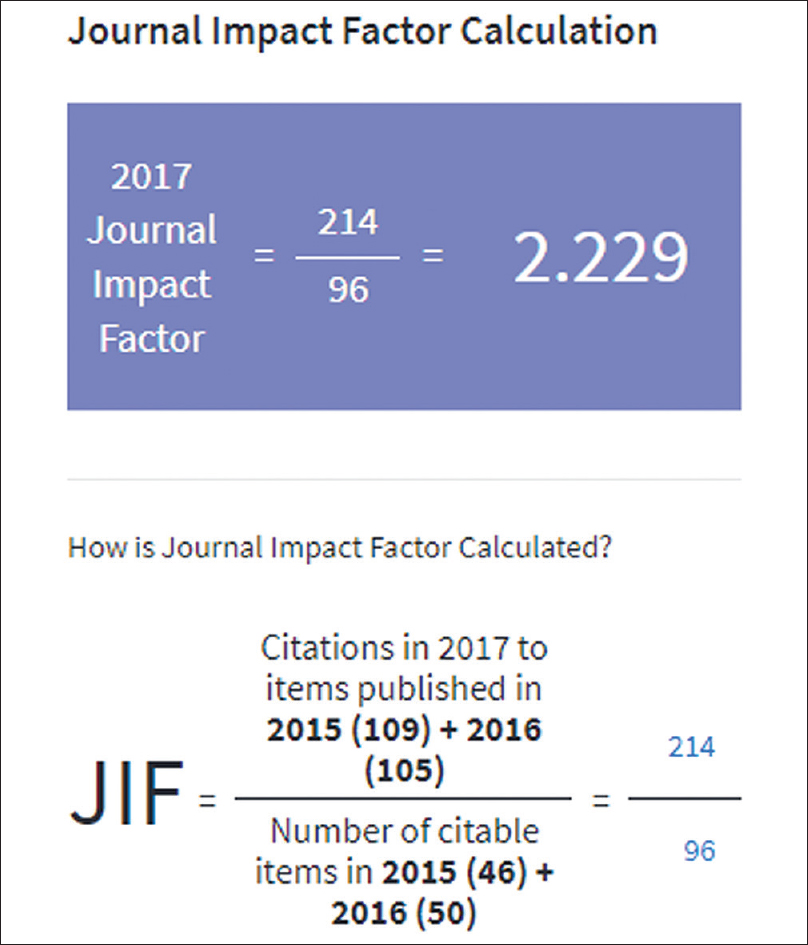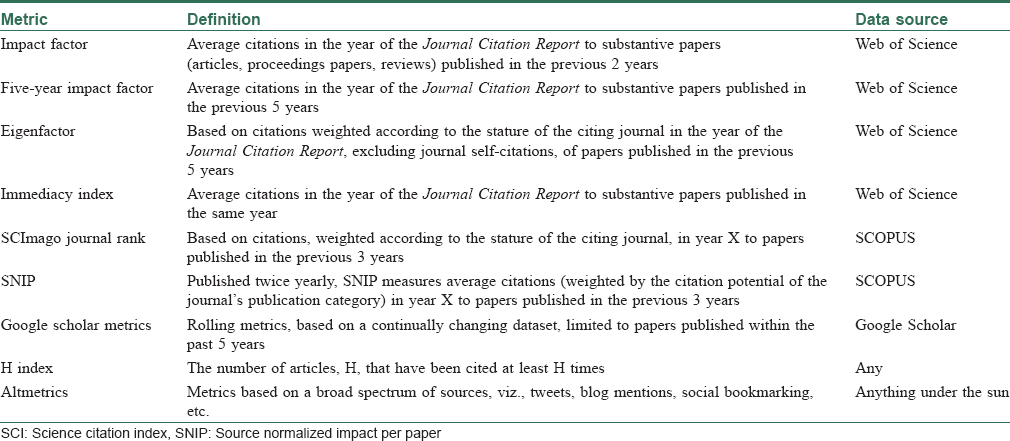Translate this page into:
IJDVL and impact factor
Correspondence Address:
Saumya Panda
Department of Dermatology, KPC Medical College, Jadavpur, Kolkata - 700 032, West Bengal
India
| How to cite this article: Panda S. IJDVL and impact factor. Indian J Dermatol Venereol Leprol 2018;84:525-527 |
The IJDVL this year breached the barrier of impact factor 2. The Journal Citation Report 2017 published by Clarivate Analytics in June, 2018 placed IJDVL 23rd in rank among 63 journals in the “dermatology” category, with an impact factor of 2.229 [Figure - 1].[1]
 |
| Figure 1: Calculation of journal impact factor 2017 of IJDVL. JIF: Journal impact factor. Source: Journal Citation Reports1 |
Among the key indicators, impact factor without journal self-cites and the 5-year impact factor also crossed 2 for the first time, recording figures of 2.093 and 2.226, respectively. Total cites rose from 1,775 in the previous year to 2,018. Similarly, the average journal impact factor percentile rose from 56.349 to 64.286 in the past year.[1]
To put these figures in perspective, IJDVL remains the highest ranked biomedical journal published in India, with only one other Indian journal having an impact factor more than 2. It is now the second ranked dermatology journal published from Asia and is now ahead of many long-established “international” dermatology journals, published from the United Kingdom, Europe and the United States.
What Do the Improvement in Metrics Mean in Real Terms?
Impact factor and the related publication metrics are easily relatable numbers that let journals be ranked the same way as experimental data. However, as in quantitative research in general, reducing the quality of research output and published documents in journals, journal quality in short, to mere numbers result in losing the more subtle, unquantifiable aspects of reality and may sometimes result in even distorting the real picture, and that is one of the major criticisms leveled against bibliometrics. Another source of criticism is: like any other numerical data, these can also be manipulated.
However, until now, even the established detractors of the impact factor have not been really able to propose any viable or superior alternative to it for assessing published research output. This includes the signatories to the San Francisco Declaration on Research Assessment (DORA) and the authors of the Leiden Manifesto, who have given calls to reject journal-based metrics, such as impact factor, as surrogate tools to judge the quality of published research. So, for better or for worse, there does not seem to be a real alternative to journal impact factor and the like as of now, when we assess the quality of a journal, and as a surrogate, the editors' performance.
Journal Impact Factor: How Does it Modulate Journal Strategy
As one can see from the above, impact factor can be an excellent short hand tool to visualize the current situation of the journal from a global perspective. How to interpret it in its entirety and to use it to modulate the journal strategy is an editorial prerogative totally.
Thus, an unethical publishing atmosphere may seek to boost impact factor artificially by anomalous citation practices such as promoting self-citation and by indulging in citation stacking, when a disproportionate number of citations are exchanged between two or more journals. However, lately such activities (such as forming citation cartels) are putting journals at risk of being excluded from the Journal Citation Report. Some journals also fall prey to the temptation of citing fake metrics as a marketing boost. These metrics are prone to providing an unrealistically high number, but are characteristically vague on the mathematical calculation behind that number or the citation database that has been used.
A list of valid citation matrices has been given in [Table - 1]. As one can see, there are differences–some minor, others substantial–between these matrices. The primary utility of using journal impact factor as the reference point is that it is deeply ingrained. Also, when one views the larger picture, it is not erroneous. As a general rule, papers published in journals with higher impact factors tend to be better and more important than those in journals with lower ones.[2]

In case of IJDVL, the rise in impact factor from 0.976 in 2009, the year the journal received the first impact factor, to 2.229 in 2017 has seen an almost uninterrupted upward trend, and is nothing short of highly creditable for a journal that is very much Indian, not only in name but also in feel and character.[1] IJDVL remains steadfastly a clinical dermatology journal with a primarily Indian authorship in mind, but with a substantial overseas contribution, mainly from the non-English speaking world. The current stature of the journal, as reflected by its impact factor, should allow it to reach wider horizons, and establish itself as a global journal with an Indian name and character. This is easier said than done, however. It is not within the reach of the editorial board to realize this vision all by itself. The publisher will have a major role to play: it has to believe in the editorial objectives and play its part to transcend the local and regional identity of the journal in order to establish it as a major global entity.
The Editorial Board also has an arduous task ahead. The glare of the impact factor can be blinding. In the relentless pursuit of higher impact factors, it is all very easy to succumb to the temptation of jettisoning the basic character of the journal. When citability becomes the primary criterion in article selection, the axe first tends to fall on the core clinical sections such as the case reports or the clinical quiz, which lack enough “originality” to be cited to a great extent, yet have tremendous value as teaching material for clinicians and students. Striking a balance is easier said than done; however, the necessity is all the more. As IJDVL is poised to spread its wings further, its editors must make all efforts to preserve its identity as a core clinical journal on a global platform.
Finally, another word of caution: even in this era of open-access publishing, there is a disquieting trend of journals with higher impact factors being predominantly closed access. In this scenario, we must not forget that the publication model of IJDVL (free to authors and open access) has contributed a great deal to its spectacular performance since the last decade. The escalation of impact factors of Indian journals were first noted around 10 years back (the process having started another 5 years back with the establishment of the Medknow Publications), and these two factors–that the journals do not demand page/publication charges and at the same time are available on the internet as open access, thanks to the publication model pioneered by Medknow–were identified as characteristics that set the Indian journals apart from the other journals on Science Citation Index.[3] IJDVL benefited as much from this model as the prudent editorial policies pursued since then, as it left behind many of the early starters among the Indian journals during its blistering bull run on the impact factor during the last decade. This piece of history must not be forgotten by the present and future leaders of our association and this journal. Let us treat this publication model as inviolate amid all our grand plans for tomorrow.
| 1. |
Journal Citation Reports 2017. Clarivate analytics; 2018.
[Google Scholar]
|
| 2. |
Tregoning J. How will you judge me if not by impact factor? Nature 2018;558:345.
[Google Scholar]
|
| 3. |
Jain NC. Impact of Indian journals is escalating. Curr Sci 2008;94:7.
[Google Scholar]
|
Fulltext Views
6,405
PDF downloads
1,497





